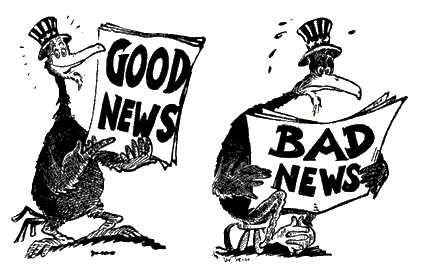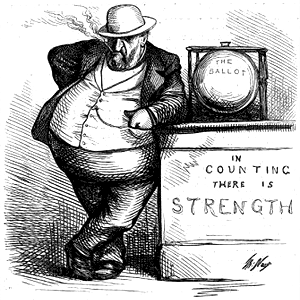 The first real political cartoons were drawn back in the early 1500's in Germany during Martin Luther's campaign against the excesses of the all-powerful Catholic Church. During this time of upheaval, Martin was looking for a way to use the new printing press to get his message out to the masses. Unfortunately, the "masses" were largely illiterate peasants who had previously relied entirely on Catholic Clergy for all access to the written word. Since the message Luther sought to distribute was inherently against the Church, he knew he needed a different way to reach the common people. The political cartoon was born.
The first real political cartoons were drawn back in the early 1500's in Germany during Martin Luther's campaign against the excesses of the all-powerful Catholic Church. During this time of upheaval, Martin was looking for a way to use the new printing press to get his message out to the masses. Unfortunately, the "masses" were largely illiterate peasants who had previously relied entirely on Catholic Clergy for all access to the written word. Since the message Luther sought to distribute was inherently against the Church, he knew he needed a different way to reach the common people. The political cartoon was born.
 Looking less like our modern cartoons and more like detailed illustrations, these early cartoons made use of familiar characters and stories to appeal to the peasants in a way that they could easily understand. One of these early cartoons shows the scene where Jesus throws the peddlers and hawkers out of the temple, a Bible story that all onlookers would easily recognize. Opposite the Bible scene is another which shows the Pope writing out and selling indulgences to the people. The comparison of the Pope to the hawkers is unmistakable. In this way, Martin could expose people of all classes to his radical and complex ideas in a way that was both simple and entertaining.
Looking less like our modern cartoons and more like detailed illustrations, these early cartoons made use of familiar characters and stories to appeal to the peasants in a way that they could easily understand. One of these early cartoons shows the scene where Jesus throws the peddlers and hawkers out of the temple, a Bible story that all onlookers would easily recognize. Opposite the Bible scene is another which shows the Pope writing out and selling indulgences to the people. The comparison of the Pope to the hawkers is unmistakable. In this way, Martin could expose people of all classes to his radical and complex ideas in a way that was both simple and entertaining.
 The first real use of political cartooning by an American was Benjamin Franklin's 1754 cartoon "Join, or Die." Its image of a snake cut into eight pieces, each of which was marked as one of the eight colonies, was a direct call to all of the British colonies to unite in common cause against the French and Indians and their plans to take over land west of the Appalachians. Later, in 1765, Franklin would again use the cartoon to try to persuade the colonies to unite in order to fight the British for independence. In both cases, the image of the snake became a stark and easily recognizable symbol around which the unity movement could coalesce.
The first real use of political cartooning by an American was Benjamin Franklin's 1754 cartoon "Join, or Die." Its image of a snake cut into eight pieces, each of which was marked as one of the eight colonies, was a direct call to all of the British colonies to unite in common cause against the French and Indians and their plans to take over land west of the Appalachians. Later, in 1765, Franklin would again use the cartoon to try to persuade the colonies to unite in order to fight the British for independence. In both cases, the image of the snake became a stark and easily recognizable symbol around which the unity movement could coalesce.
 The cartoon medium works well as a way for a new idea to gain a foothold in the public consciousness because of the brief and simple message it conveys. Since many cartoons couch their dissenting ideas in humor or satire, the artist can get away with making a radical idea seem more socially acceptable and less dangerous to the powers that be.
The cartoon medium works well as a way for a new idea to gain a foothold in the public consciousness because of the brief and simple message it conveys. Since many cartoons couch their dissenting ideas in humor or satire, the artist can get away with making a radical idea seem more socially acceptable and less dangerous to the powers that be.
Cartoons continued to have huge importance in American politics during some of the more turbulent times in our nation's history, like the government corruption of the late 1800's, when Thomas Nast drew his famous "Boss" Tweed character to skewer thieving politicians. It was during this time that America's first humor magazine, "Puck," was started, creating a new, larger forum for political cartoons.
 During the early 1950s, the term "McCarthyism" was coined by the cartoons of Herblock, one of the first people to publicly question Senator McCarthy's communist witch hunt. Today, political cartoons still entertain and inflame readers of print publications, but perhaps a more modern incarnation of their ability to educate through humor and depictions of the absurd exists in television shows like "The Daily Show" and "The Colbert Report."
During the early 1950s, the term "McCarthyism" was coined by the cartoons of Herblock, one of the first people to publicly question Senator McCarthy's communist witch hunt. Today, political cartoons still entertain and inflame readers of print publications, but perhaps a more modern incarnation of their ability to educate through humor and depictions of the absurd exists in television shows like "The Daily Show" and "The Colbert Report."

Grab The Bookmarketer For Your Site




No comments:
Post a Comment